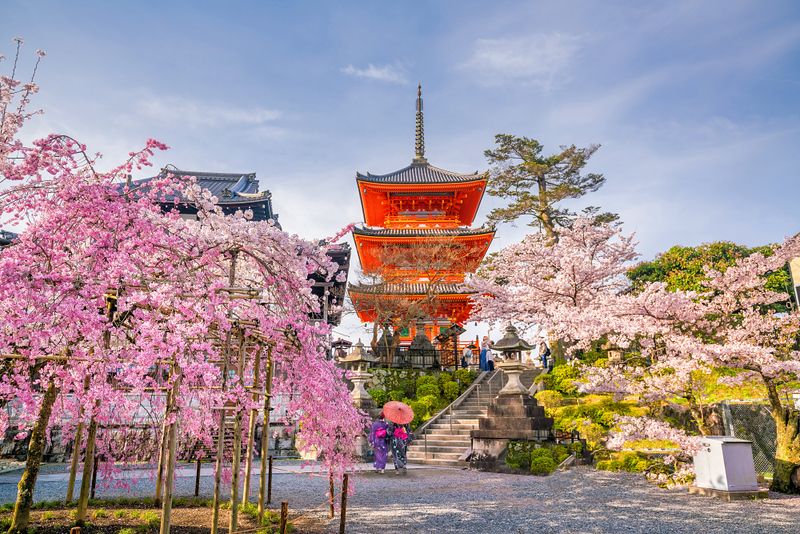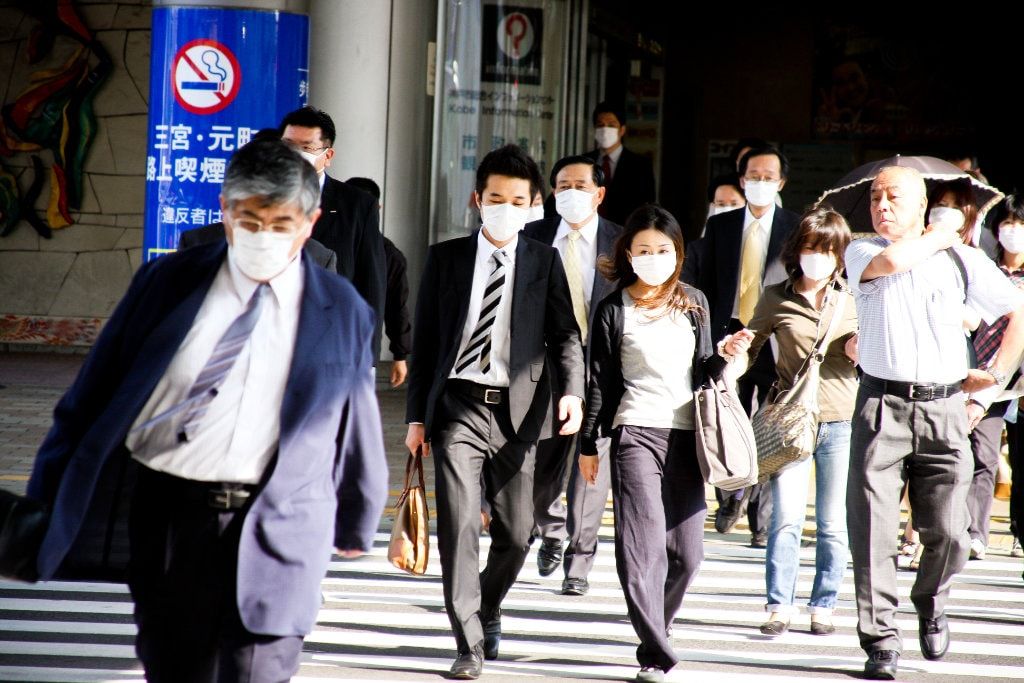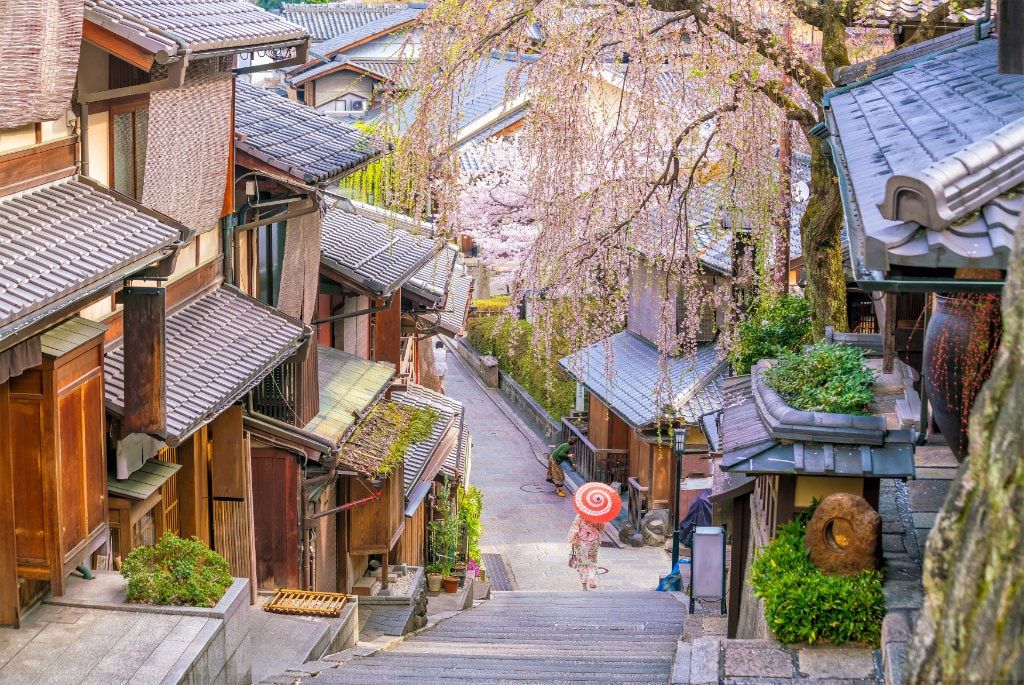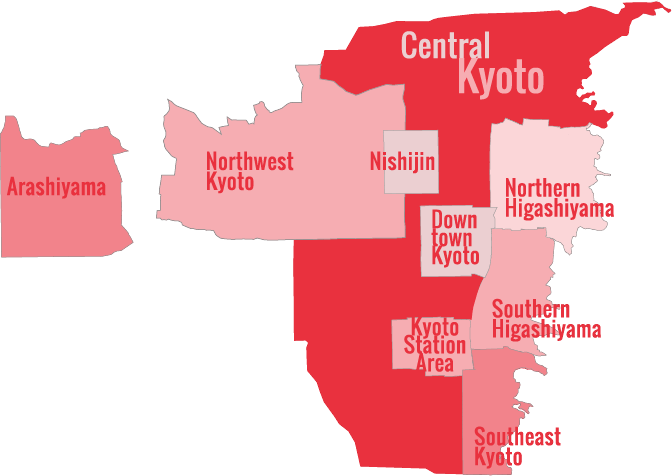A Kyoto Travel Guide
Can I Travel To Japan Now? March 2022
Foreign business people and students can now enter Japan with minimal or no quarantine as long as you have a proper visa (you must apply in advance). Tourists are still barred from entry, but we are hoping for good news soon. Here are all the details on travel restrictions, flights, and entry procedures.

Kiyomizu-dera Temple with cherries in full bloom: f11 photo / Shutterstock.com
Situation Summary
Last update: March 14, 2022 (this page is updated every Monday)
- Foreign business travelers and students can enter Japan as long as they have the proper visa (you must apply in advance and you’ll need a sponsor in Japan).
- Quarantine for business travelers and students will be three days for some and eliminated for those from countries where Covid is controlled (including the United States).
- Tourists are still barred from entry but we hope to hear some good news soon.
- The Omicron wave has peaked and is now rapidly declining in Japan.
- We will update this page weekly on Mondays, Japan time.
- Japan is still closed to tourists now, but will reopen in the future. Now is the time to start planning a trip to Japan. Contact Chris Rowthorn to start planning.
- Want to be alerted as soon as Japan announces reopening? Scroll down and sign up for our newsletter.
Odds of Japan Reopening to Tourism (personal opinion/explanation below):
- March 2022: 5%
- April 2022: 35%
- May 2022: 60%
- July 2022: 85%
Commentary by Chris
Starting March 1, foreign business travelers and students can enter Japan, provided they have the proper visa (you must apply in advance at a Japanese embassy or consulate – you will need a sponsor in Japan). Quarantine for these travelers, as long as they are boosted, will be three days for most countries and eliminated for those coming from countries where Covid has been controlled. At present, this latter group of countries includes the United States, Australia and Thailand.
As far as we can tell, travelers who have not received a Covid vaccine will have to quarantine for three days and can be released upon negative text. It appears that it will be possible to do this quarantine at a hotel.
The government has announced a simplified online application procedure for Japanese sponsors of business and student visa applicants. So, this procedure should be greatly speeded up on March 1.
There has been no announcement regarding tourists but Prime Minister Kishida recently said: "We hope to gradually increase international travel while taking into consideration the infection situation at home and abroad." Thus, we expect to hear something regarding tourists in the next few weeks.
The main question for Japan travel is this: Based on the above changes, will Japan react fast enough to get the country open to tourists by the late March cherry blossom season? As you can see above, I’m giving a March opening a 5% chance and an April opening a 35% chance. If we don’t hear some really positive news from the Japanese government in the next few weeks, it might be wise to plan for an opening in May or June. Whatever you do, I’d suggest that you be prepared to be flexible. Check cancellation and rescheduling fees and have a Plan B in mind.
Latest Japan Coronavirus News
- Japan Times: Weekly COVID-19 Updates and Bulletins Roundup – March 11
- EuroNews: WHO Calls for End to International Travel Restrictions
- Japan Times: Details on New Entry Policy and Procedures
- Japan Times: Japan Seeks to Further Ease Entry Restrictions
- Japan Times: Japan Starts Online Process for Visa Sponsors
- Japan Times: Japan Raises Entry Cap and Ditches Event Size Limits
Is Japan Open for Travel Now?
Starting March 1, foreign business travelers and students can enter Japan provided they have the proper visa (apply in advance at the nearest Japan embassy or consulate – you will need a sponsor in Japan). Tourists cannot presently enter but we hope to hear an announcement soon about when they will be able to enter.
Please check the Japan Ministry of Foreign Affairs site (MOFA) for the latest details. Because that page is quite confusing, you may also want to call the Japanese embassy or consulate nearest you.
Alternatively, the United States Embassy in Tokyo has the clearest information on the specifics of the new entry policy here (scroll down to "Entry and Exit Requirements").
What Will You Need to Enter Japan When It Reopens?
Although Japan has not formally announced how and when they will reopen to tourists, we can guess about what a reopening will look like based on how they’ve been reopening to foreign residents and business people. Based on this information, you can start to make some sensible preparations for the time when Japan does actually open its doors again. Here are some key points:
- A negative COVID test will likely be necessary within 72 hours of boarding your flight to Japan. You’ll almost certainly be asked to show proof of this when you check in for your flight, and you’ll have to show it to Japanese immigration upon arrival. At this point, there are two acceptable tests: the PCR test and the CLEIA quantitative antigen test. You might start researching where you can get such a test on this timetable, including airports where such testing services are available.
- The Japanese government websites are confusing and self-contradictory regarding COVID-related issues. See the US Embassy in Tokyo’s site listed above for the clearest and most up-to-date details.
- If worst comes to worst, you want to be sure that your travel insurance policy. World Nomads policies do cover COVID treatment. For more details, visit our travel insurance page.
We will continue to monitor developments around opening closely. As soon as Japan announces the details, we will publish them here. We aim to give full details on entry requirements, application procedures, and actual experiences with entering Japan, so check back frequently.
Flights to Japan Currently Operating
Here are cities with direct flights to Japan and the airlines that operate them. Most flights go to Tokyo (Narita or Haneda), but some flights also go to Kansai (Osaka, Kyoto). Most Kansai flights come from Asia, but we’ve heard that United Airlines is restarting their San Francisco-Kansai flight at the end of March. Most flights here are not daily, but a few times a week.

Japan Airlines planes at Narita International Airport: EQRoy / Shutterstock.com
North America
- Vancouver: Air Canada, ANA, Japan Airlines, American Airlines
- San Francisco: United, American, ANA, Japan Airlines
- Los Angeles: United, American, ANA, Japan Airlines, Singapore Airlines
- Chicago: United, American, ANA, Japan Airlines
- Dallas/Fort Worth: American, Japan Airlines
- New York: United, American, ANA, Japan Airlines
Europe
- London: British Airways, ANA, Japan Airlines
- Paris: Air France, ANA, Japan Airlines
- Frankfurt: Lufthansa, ANA, Japan Airlines, Finnair, British Airways
- Helsinki: Finnair, British Airways, Japan Airlines
- Istanbul: Turkish Airlines, ANA
Oceania
- Sydney: Qantas, ANA, Japan Airlines
Asia
- Bangkok: Thai, Bangkok Airways, ZIPAIR, ANA, Japan Airlines
- KL: Malaysia, ANA, Japan Airlines
- HCMC: Viet Jet Air, Vietname, ANA, Japan Airlines
- Hong Kong: Cathay, Hong Kong Express, ANA, Japan Airlines
- Taipei: China Airlines, EVA, Scoot, Starlux, ANA, Japan Airlines
- Singapore: Singapore Airlines, ANA, Japan Airlines
- Seoul: Korean Air, Asiana, Ethiopian, ANA, Japan Airlines
Here are links to Japanese airlines COVID-19 countermeasures pages:
Hotels Emphasizing Safety and Hygiene in Japan
Almost all hotels in Japan are taking extreme precautions to make their properties as safe as possible. Other forms of accommodation are also taking extensive safety measures. Click the links below for the details on their COVID countermeasures.

Mandarin Oriental Tokyo guest room
Kyoto
Tokyo
Japan Coronavirus Information
At the time of writing, Japan has been experiencing around 49,000 new cases a day, according to the Japan COVID-19 Tracker. Japan has had around total 45,000 cases per million people. The Omicron wave has peaked and cases are falling rapidly.
Here is a useful link for the latest coronavirus numbers on Japan:

People wearing masks in Kobe: Hinochika / Shutterstock.com
Tips for Safe Travel in Japan
Here are some useful tips to ensure a safe trip during these unusual times.
- Masks are available at drug stores, supermarkets and some department stores. You can also pick them up at airports in Japan. If you can’t find them, you can simply ask someone: "masuku arimasu-ka?" (Do you have masks?) or show them this: マスクを探しています。
- Hand sanitizer is available at most places that sell masks (see above).
- If you want as much distance around you as possible on trains, consider green cars, especially on the shinkansen.
- Many restaurants in Japan offer private rooms, which are called "koshitsu." Your hotel concierge can help you locate such restaurants and reserve them for you.
- Consider visiting popular destinations early in the morning or just before they close in the late afternoon. Or, consider visiting off-the-beaten-track destinations.
- Avoid crowded areas. Here are some tips on how to avoid the crowds in Kyoto.

Kyoto in cherry blossom season: f11 photo / Shutterstock.com
More Useful Information
Kyoto Vacation Checklist
- For all the essentials in a brief overview, see my First Time In Kyoto guide
- Check Kyoto accommodation availability on Booking.com – usually you can reserve a room with no upfront payment. Pay when you check out. Free cancellations too
- Need tips on where to stay? See my one page guide Where To Stay In Kyoto
- See my comprehensive Packing List For Japan
- Buy a data-only SIM card online for collection when you arrive at Kansai International Airport (for Osaka and Kyoto) or Tokyo's Narita Airport. Or rent an unlimited data pocket wifi router
- Compare Japan flight prices and timings to find the best deals
- If you're visiting more than one city, save a ton of money with a Japan Rail Pass – here's my explanation of why it's worth it
- A prepaid Icoca card makes travelling around Kyoto easy – here's how
- Get travel insurance for Japan - World Nomads is well-regarded (and here's why)
Kyoto District Map
Click a Kyoto District for detailed info on attractions, places to eat and accommodation
Welcome To InsideKyoto.com

Chris Rowthorn Tours
Visit ChrisRowthorn.com and read customer reviews on TripAdvisor
Private Kyoto Walking Tours
- Kyoto Walking Tours Overivew
- Kyoto Walking Tour 1: Nanzen-ji Temple to Yoshida-jinja Shrine
- Kyoto Walking Tour 2: Tofuku-ji Temple to Fushimi-Inari Taisha Shrine
- Kyoto Walking Tour 3: Classic Southern Higashiyama
- Kyoto Walking Tour 4: Gion Evening Walk
- Kyoto Walking Tour 5: Arashiyama
- Japan Travel Consulting
First Time In Kyoto
Kyoto Itineraries
- Kyoto Itineraries – 1 to 5 Days In Kyoto
- Must See Kyoto 1 Day Itinerary
- Kyoto Two-Day Itinerary
- Kyoto Three-Day Itinerary
- Kyoto Five-Day Itinerary
- Kyoto Itineraries for Families with Children
- 1-Day Kyoto Foodie Itinerary
- 1-Day Kyoto Vegetarian Foodie Itinerary
- Kyoto Walking Itineraries
- Arashiyama Bamboo Grove Walking Tour
- Kyoto One-Day Off-the-Beaten-Track Cherry Blossom Itinerary
- Kyoto Evening Cherry Blossom Itinerary
- Fushimi-Inari Hike
- Kyoto Off The Beaten Track Itineraries
- How To Escape The Crowds In Kyoto
- How Much Money Do I Need For Kyoto?
- Kyoto on US$100 a Day
Things To Do In Kyoto
- Things To Do In Kyoto Overview – Start Here!
- Kyoto Must-Do
- What’s New in Kyoto 2019
- Autumn Colors In Kyoto (Fall Foliage)
- Cherry Blossom Season In Kyoto
- Where To Stay If Kyoto Is Fully Booked
- The Best Temples in Kyoto
- The Best Shinto Shrines in Kyoto
- Kyoto Geisha
- Kyoto’s Best Zen Gardens
- Chris Rowthorn’s 10 Favorite Kyoto Temples
- Kyoto’s Best Sentos – Japanese Public Baths
- Kyoto’s Best Onsen – Hot Spring Baths
- Kyoto’s Best Gardens
- Kyoto UNESCO World Heritage Sites
- Kyoto Festivals and Events
- Internet In Japan For Tourists: Wifi, Pocket Wifi, SIM Cards, Rental Phones etc
- Kyoto Shopping – The Best Shops And Gifts
- Kyoto Art and Antiques
- Kyoto Arts – Geisha, Kabuki and more
- Kabuki At Kyoto’s Minamiza Theater
- Kyoto Activities
- Walking In Gion
- Walking The Path Of Philosophy
- Kyoto Tea Ceremony
- Tea in Kyoto
- Best Coffee In Kyoto
- Fushimi: Kyoto’s Sake District
- Kyoto Samurai
- Sword Dancing in Kyoto at Samurai Kembu Theater
- Sanjo-kai Shotengai Shopping Arcade
- Backpacking In Kyoto
- Solo Travel in Kyoto (and the Rest of Japan)
- Solo Female Travel in Kyoto (and the Rest of Japan)
- Kyoto With Children
- Kyoto’s Best Green Spaces
- Kyoto Secret Spots
- Cycling In Kyoto
- Best Kyoto Hikes
- Sumo Wrestling In Kyoto
- Renting A Car In Kyoto
- Chris Rowthorn’s Favorite Books on Japan
- Chris Rowthorn’s Favorite Movies, TV Shows and Documentaries on Japan
- Gay and Lesbian Kyoto
- Jewish Kyoto
Kyoto Machiya
Kyoto Hotels
- The Best Places to Stay in Kyoto
- Best Value Hotels In Kyoto
- Kyoto Vacation Rentals
- Best Luxury Hotels in Kyoto
- Best Boutique Hotels in Kyoto
- Business Hotels In Kyoto
- Best Mid-Range Hotels in Kyoto
- Best Budget Hotels In Kyoto
- Best Kyoto Hostels And Guesthouses
- Best Kyoto Hotels for Families
- Best Kyoto Hotels for Sightseeing
- Where To Stay In Kyoto
Kyoto Daytrips and Overnight Trips
- Kurama And Kibune
- Ohara
- Takao
- Uji
- The Kumano Kodo Walking Trail: A Guide with Maps
- Walking the Nakasendo from Kyoto Guide and Map
- Himeji Day Trip Itinerary
- Naoshima Art Island Travel Guide
- Noto-hanto Peninsula Travel Guide
- Kinosaki Onsen Guide and Map
- Exploring the Tango-hanto Peninsula
- The Kitayama Area: Bujo-ji, Miyama, Kayabuki-no-Sato
Kyoto Eating
- What To Eat In Kyoto
- Best Restaurants In Kyoto
- Kyoto Restaurants Near The Sights
- Kyoto Cheap Eats
- Gluten-Free Kyoto
- Best Affordable Sushi in Kyoto
- Best Cafes in Kyoto
- Best Coffee In Kyoto
- Best Gyoza in Kyoto
- Best Izakaya in Kyoto
- Best Japanese Tea and Sweet Shops in Kyoto
- Best Kaiseki (Japanese haute cuisine) in Kyoto
- Best Kissaten in Kyoto
- Best Okonomiyaki in Kyoto
- Best Ramen in Kyoto
- Best Resutoran-gai in Kyoto
- Best Shojin Ryori (Japanese Buddhist vegetarian cuisine)
- Best Shokudo (All Round Restaurants) in Kyoto
- Best Soba and Udon in Kyoto
- Best Sukiyaki in Kyoto
- Best Tempura in Kyoto
- Best Tofu Cuisine In Kyoto
- Best Tonkatsu in Kyoto
- Best Unagi in Kyoto
- Best Vegan and Vegetarian in Kyoto
- Best Yakitori in Kyoto
How To Get To Kyoto
- The Nearest Airport To Kyoto and Kyoto Airport Transport
- Arriving at Kansai International Airport (KIX)
- Kansai International Airport (KIX) Airport Guide
- Kansai International Airport (KIX) Hotels
- How To Buy Shinkansen Bullet Train Tickets
- How to Buy Japan Rail Tickets and Shinkansen Tickets Online
- Japan Rail Pass – Is It Worth It?
- JR Trains: Green Cars Versus Ordinary Cars
- Ferry Trips From Kyoto
- Japan Ferry Pass 21 – A Great Way to Explore Japan
- How to Travel from Kyoto to Busan by Ferry
Kyoto SIM Cards and Wifi
Japan Itineraries
- Japan Itineraries Overview
- 1 Week Japan Itinerary: Tokyo and Kyoto
- 7 to 10 Day Japan Itinerary: Kyoto, Nara, Osaka and Hiroshima
- 10 Day Japan Itinerary: Tokyo, Kyoto and Takayama
- 10 Day Japan Itinerary: Tokyo, Kyoto and Kanazawa
- 2 Week Japan Itinerary: The Grand Tour
- Japan Itinerary For Traveling With Children
- Japan Cherry Blossoms
- Japan Autumn Foliage
- Hiking in Japan – A Full Guide
- Japan Rail Pass: How To Make The Most Of It
Japan Travel Insurance
Japan Visa
Disclosure: InsideKyoto.com is a participant in the Amazon Services LLC Associates Program, an affiliate advertising program
designed to provide a means for sites to earn advertising fees by advertising and linking to amazon.com and amazon.co.uk.

